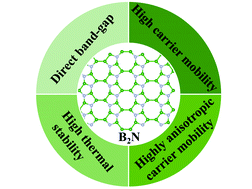A B2N monolayer: a direct band gap semiconductor with high and highly anisotropic carrier mobility†
Abstract
Two-dimensional materials with a planar lattice, suitable direct band gap, and high and highly anisotropic carrier mobility are desirable for the development of advanced field-effect transistors. Here we predict three thermodynamically stable B-rich 2D B–N compounds with the stoichiometries of B2N, B3N, and B4N using a combination of crystal structure searches and first-principles calculations. Among them, B2N has an ultraflat surface and consists of eight-membered B6N2 and pentagonal B3N2 rings. The eight-membered B6N2 rings are linked to each other through both edge-sharing (in the y direction) and bridging B3N2 pentagons (in the x direction). B2N is a semiconductor with a direct band gap of 1.96 eV, and the nature of the direct band gap is well preserved in bilayer B2N. The hole mobility of B2N is as high as 0.6 × 103 cm2 V−1 s−1 along the y direction, 7.5 times that in the x direction. These combined novel properties render the B2N monolayer as a natural example in the field of two-dimensional functional materials with broad application potential for use in field-effect transistors.



 Please wait while we load your content...
Please wait while we load your content...